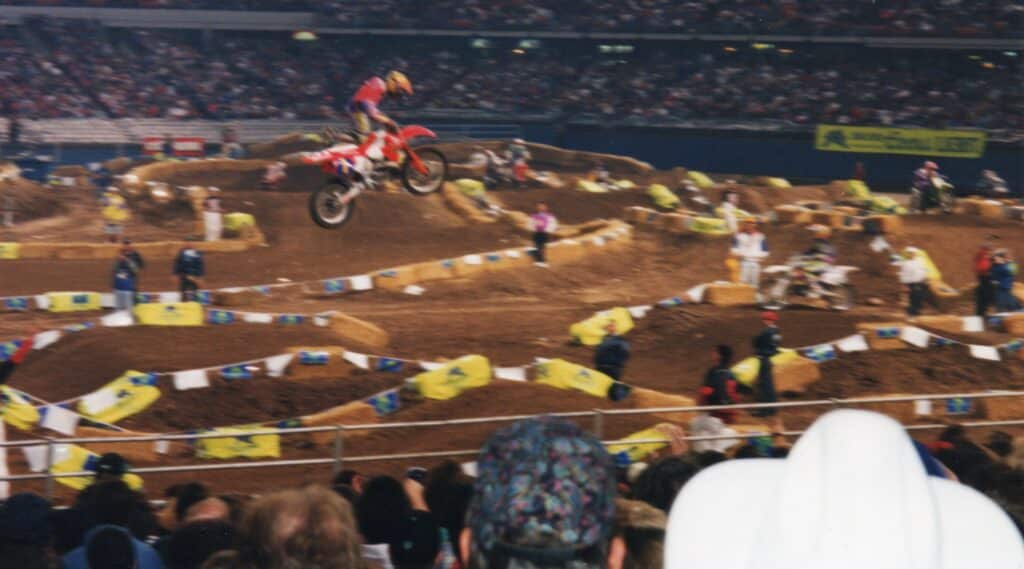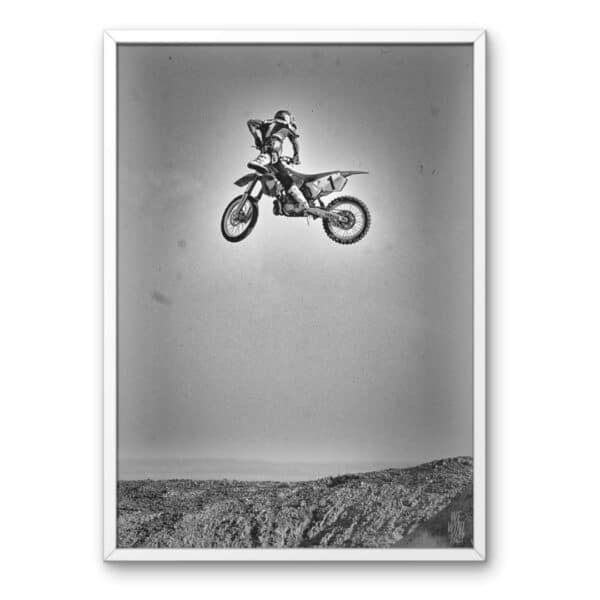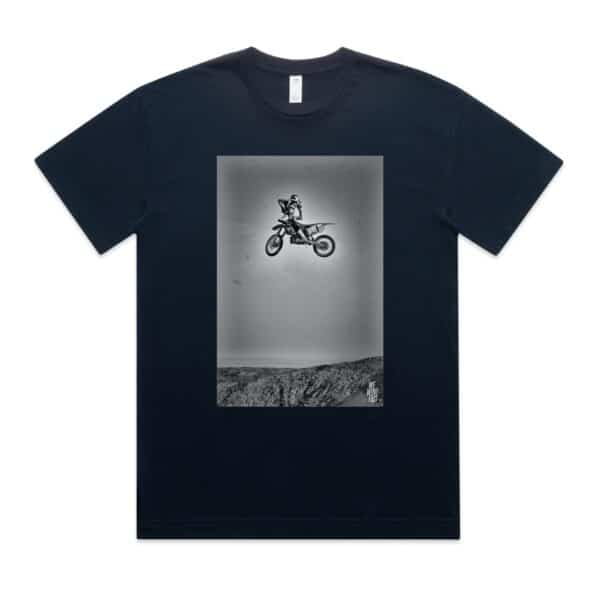A Nac for Style: How Jeremy McGrath Brought the Nac Nac to Supercross
By
The Nac Nac was a little used BMX trick with contentious origins; then Jeremy McGrath did it on a dirt bike and changed the game.
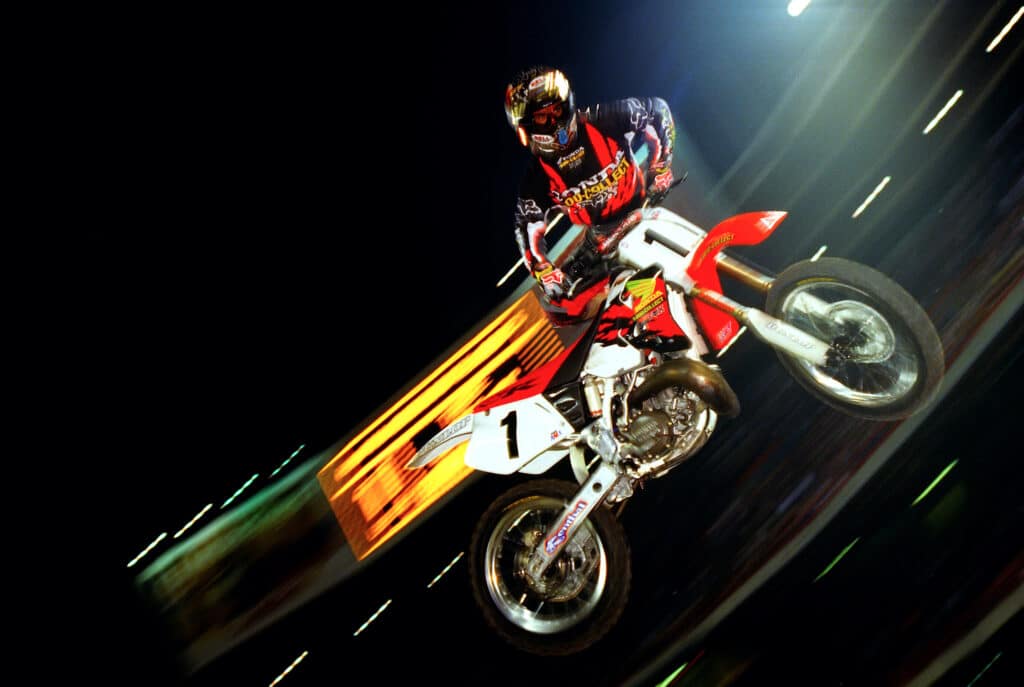
Skip Norfolk started running. Watching from the ground level, he saw Jeremy McGrath go into the air with his right leg being pulled off the back of the motorcycle but he fell out of view before landing.
Jack McGrath clutched his chest. Sitting in the press box, which was located above the triples, he thought his son had lost control of the bike.
Journalist Chris Jonnum looked around and wondered if anyone else had witnessed what he thought he saw. He figured he might have a scoop and made a note to ask McGrath about it later.
Jeremy McGrath Nac Nac Print
Davey Coombs, watching from a metal end zone bleacher in Orlando’s Citrus Bowl, “sat there in silent disbelief, my camera at my side,” he wrote in a Cycle News column published February 2, 1994.
In a 1994 afternoon practice session at round one of what was then called the AMA Camel Supercross Series, Mike LaRocco, Mike Kiedrowski, Jeff Emig, Jeff Stanton, Brian Swink and others used their time to learn the course, make bike setup changes and calm the butterflies that flutter in anticipation of important events. McGrath, however, was in a dress rehearsal for the victory lap trick he was planning to unveil that evening.
On the last lap of practice at the Orlando Supercross, McGrath jumped the press box triples, briefly dismounted his Honda CR250 while glancing over at a bank of empty seats and quickly brought his right leg back to the foot peg. Nobody on McGrath’s team – his father, his mechanic, his manager – knew what the 22-year-old defending supercross champion was up to.
They thought he was crashing, but when he landed with the ease and grace that was his usual style, they met him back at the Honda box van with looks of disgust.
“He comes back in all grins and I had zero emotion,” said Norfolk, McGrath’s mechanic. “If I was a cat, I lost three lives just then.” Jack McGrath was furious and admonished his son in a fatherly manner to focus on winning races instead of trickery. Dave Arnold, Honda’s team manager pulled Norfolk aside and said, “The next time your rider wants to do some crazy trick, make sure he tells us! He came off his motorcycle in the air!”
When Norfolk calmed down, he said to McGrath, “That was cool, what did you do?” After months of backyard sessions with his old BMX racing pal Eric Carter, jump contests at European Supercross races in late 1993 and a week in Oklahoma with Guy Cooper, McGrath publicly performed the nac nac for the first time in America, albeit in front of a mostly empty 65,000 seat stadium.
Snapped: Jeremy McGrath
Although the trick became the identity and avatar of the rider already called Showtime, and soon to be the King, it took weeks before the media was able to properly identify it. At round two in Houston, Cycle News still called it the “patented” leg-over-seat maneuver and ESPN’s Art Eckman called it the can can for several weeks.
It’s hard to fault the motorcycle industry for being confused; in 1994 the whip was still the most breathtaking aerial move and nobody was yet used to seeing motorcycle riders acrobatically dangling from their machines.
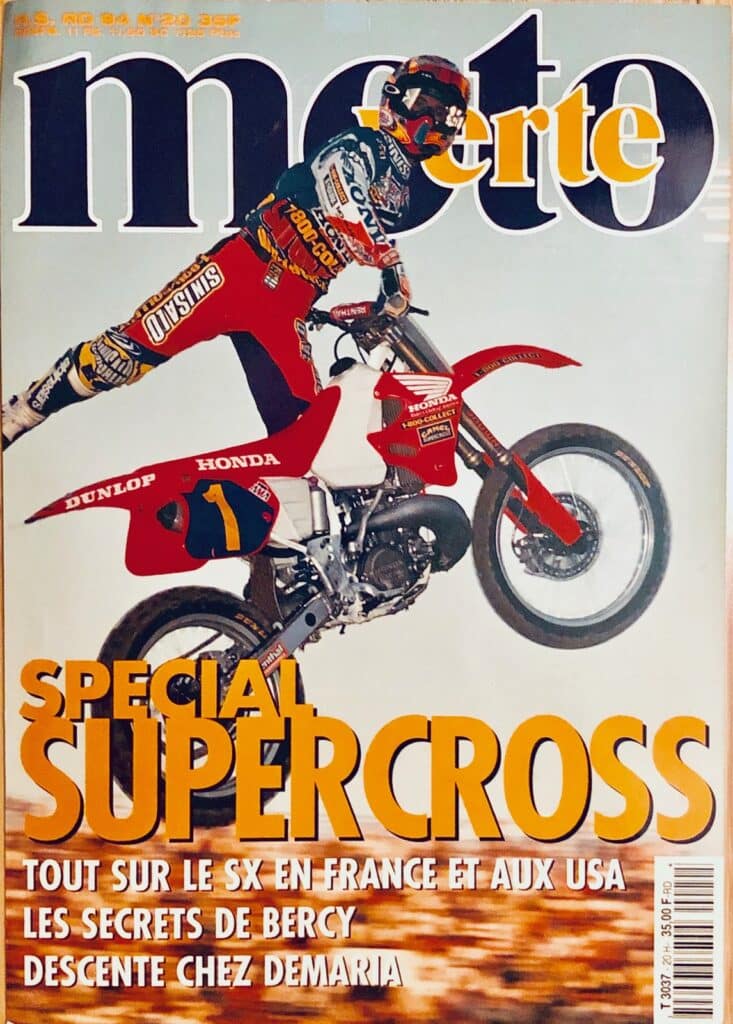
The Enchanted Ramp
What most people forget – or never knew – is that the origin of the nac nac has a highly convoluted history in the world of BMX that traces back to the summer of 1987 on a nine and a half foot tall halfpipe in the shadow of an avocado tree in Leucadia, CA.
Or, depending on who is asked, it was first hucked by a group of rippers in Belfast, Northern Ireland in the late 80s. Either way, in the late 80s the trick popped up in the pages of BMX Action, which, along with BMX Plus, Freestylin’, Go and others, were the bibles of the BMX freestyle movement.
The young sport, created by Bob Haro, was growing so fast in the mid-80s they couldn’t keep track of the tricks being invented. Riding sessions didn’t always have cameras present and those that did were called photo shoots, unlike today where sessions don’t happen at all without photos being shot and a video camera is attached to anything that moves.
Any new trick that was pulled showed up in a magazine three months later and during that gap a dozen other riders may have already learned it.
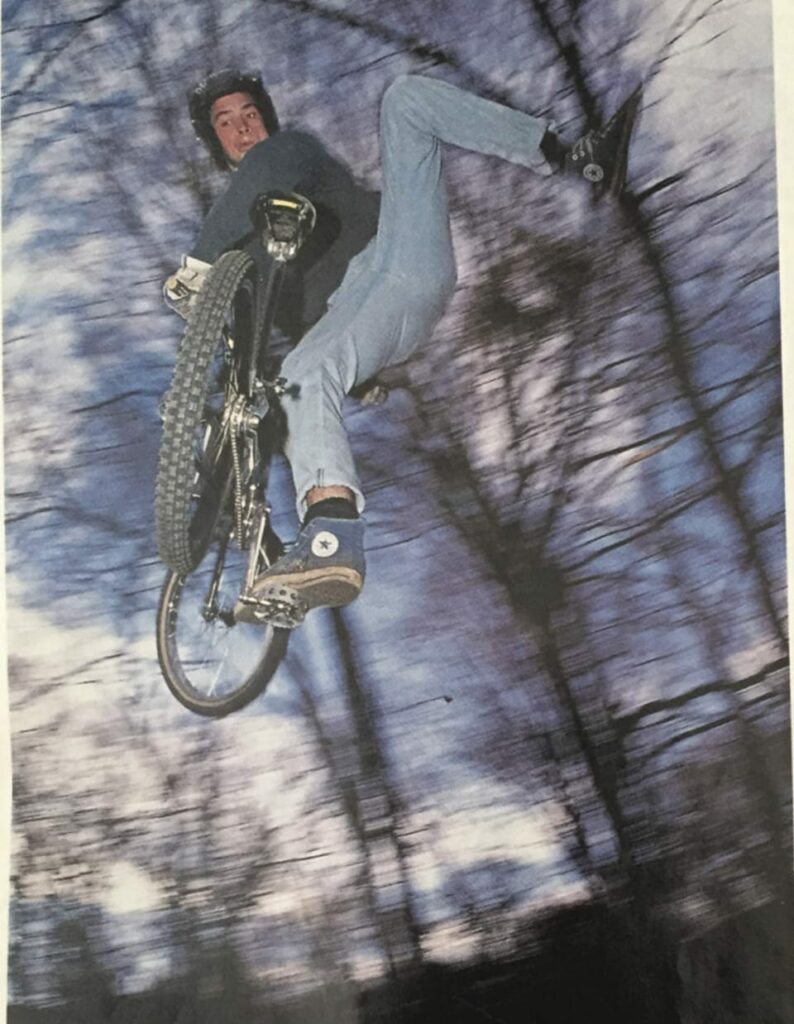
One summer day, 1987, Andy McSorley was a 14-year-old grom happy to not be kicking stones in his backyard. Standing on the top of the Enchanted Ramp, the fabled private halfpipe in Leucadia, CA that belonged to BMX rider Ron Wilkerson, McSorley made a suggestion to Brian Blyther, one of the top BMX freestyle pros of the time and also the guy who allowed him to tag along to the session. Blyther, then 19, was known for blasting big airs and can cans that peaked well above the fence line.
“Have you ever tried to put your can can foot behind instead of in front?” McSorley recounted asking Blyther. “He took two airs before he had it dialed and it was stylish.”
Blyther didn’t like the trick at first. Without forward momentum, the “back can” as it was called by BMX Action when the first photos were eventually shot and published, was more of a step through, with the leg in motion passing behind the calf, instead of swinging out over the seat and rear wheel of the bike, while the body twisted to play to a crowd of spectators.
“It didn’t feel like it looked good,” said Blyther, who is now a Montclair, CA police officer. Blyther remembers well the afternoon with McSorley, and the suggestion, but the trick became just another part of his routine and wasn’t something that earned him any extra notoriety.
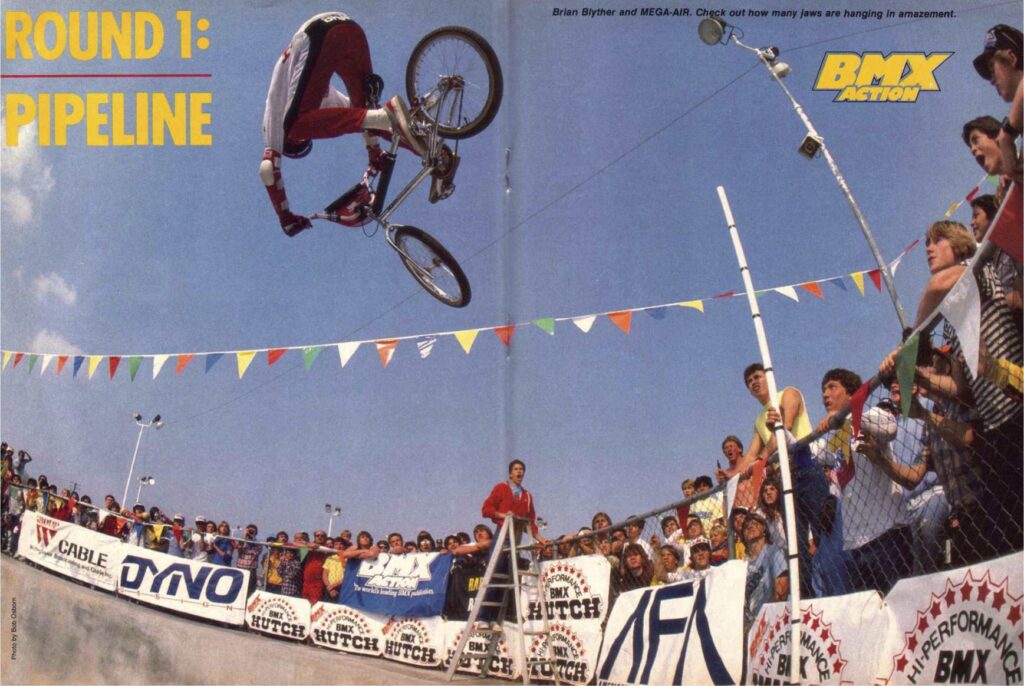
Meanwhile, in Northern Ireland…
In Belfast, a young rider named Will Smyth was devouring magazines and hitting ramps with his friends. They saw a photo of Blyther’s back can and started incorporating it into their dirt jump routines. With forward momentum on the dirt doubles, they learned to swing their legs out wide and whip the bike out in front.
When Smyth saw a Spike Jonze photo of Cory Unger doing the trick in a Sept. 1988 issue of BMX Action – captioned as the ‘don’t don’t – he wrote to Editor, Craig “Gork” Barrette, and told him what he and his friends had been up to in Northern Ireland and that they called it a nac nac (can can backwards).
“We were obsessive at the time,” said Smyth, who co-founded Dig magazine in 1993 and is still the editor and publisher. More photos ran in the ensuing months and finally, in the March 1989 issue, Smyth, by then a test rider for BMX Action, got a photo published of him pulling the contentiously named trick with the caption, “Nac nac. Who’s there? Will Smyth.” The name stuck.
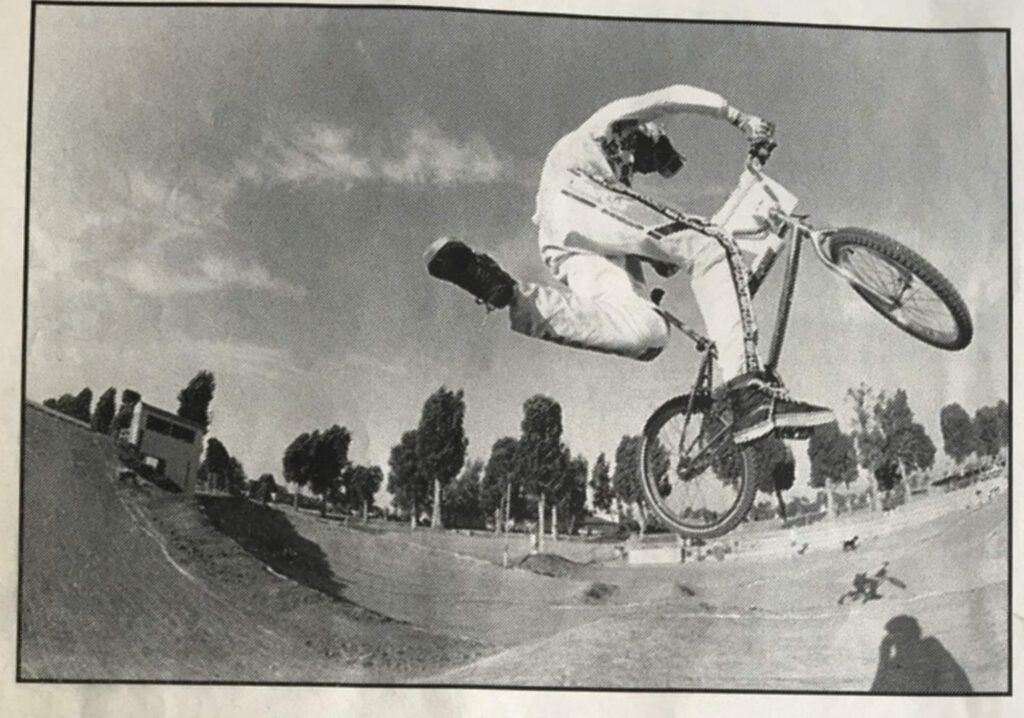
Smyth feels there are major differences in the vert version of the trick compared to the dirt version he and his friends were doing but cites Blyther’s back can as his inspiration. The story could get more complicated, like trying to figure out who did the first one-hander over a motocross finish line, but the brightest signs point to Blyther as the nac nac originator, even if his vert ramp version is different than the dirt version. The kicker is that Blyther, who was the King of Vert champion in 1987 and 1988, doesn’t care if he gets credit or not.
“I don’t go out trying to lay claims,” Blyther said. “It’s strange to me. Thinking back, it is a huge trick now. It’s McGrath’s staple trick but it wasn’t something that was an awesome trick for me to do in every run.”
What does all this BMX history have to do with Jeremy McGrath? When Blyther was riding the walls in Upland, CA at a place called Pipeline, McGrath was a young teenager hanging out at the fence after his BMX races had ended. The nac nac came shortly after McGrath quit racing bicycles but he has vivid memories of watching Blyther, Eddie Fiola and Mike Dominguez blasting airs out of the pool and hucking huge can cans.
McGrath said he loved to jump and built rhythm sections at home but, for reasons he still doesn’t know today, he didn’t ride Pipeline on his bicycle as a youth. He loved watching but wasn’t interest in the scene; instead, he skateboarded at Pipeline because that’s what all of his friends were doing. He also had a quarterpipe in his garage, built by his dad and skated in the drainage ditches near his home.
Jeremy McGrath @ Anaheim
“I have Alligator Arms”
In the fall of 1993 McGrath had just finished up his first true full season as a professional motorcycle racer: 16 rounds of supercross, 12 rounds of motocross and the Motocross of Nations in Austria (a race McGrath admits was extremely stressful in ’93).
During the downtime leading up to the ’93 FIM World Supercross Races in Nov. and Dec. he spent time riding with BMX Racer and friend, Eric Carter, in the backyard of his parents’ Sun City house, which sits next to the northbound side of I-215. McGrath loves to play ride and work on his style and Carter remembers suggesting that he try a can can over the triples.
“I have alligator arms,” McGrath said. “I could never get my legs over the tank.” Then Carter suggested a superman but Jeremy didn’t like the idea of having both feet off the pegs. Finally, try a nac nac. “How is that going to work?” McGrath remembered his reaction being. He had never tried that trick on a bicycle.
The first one was very awkward because the spinning of the wheels coupled with all the body weight coming to the left side of the bike went against physics in the air. Even after he brought the trick to AMA Supercross races he still felt like he was fighting the bike. He wasn’t sure if he should have been leaning with the bike or against it and if he tried to whip out the rear end, like he does now, would he be able to get it back? Comfort came over time.
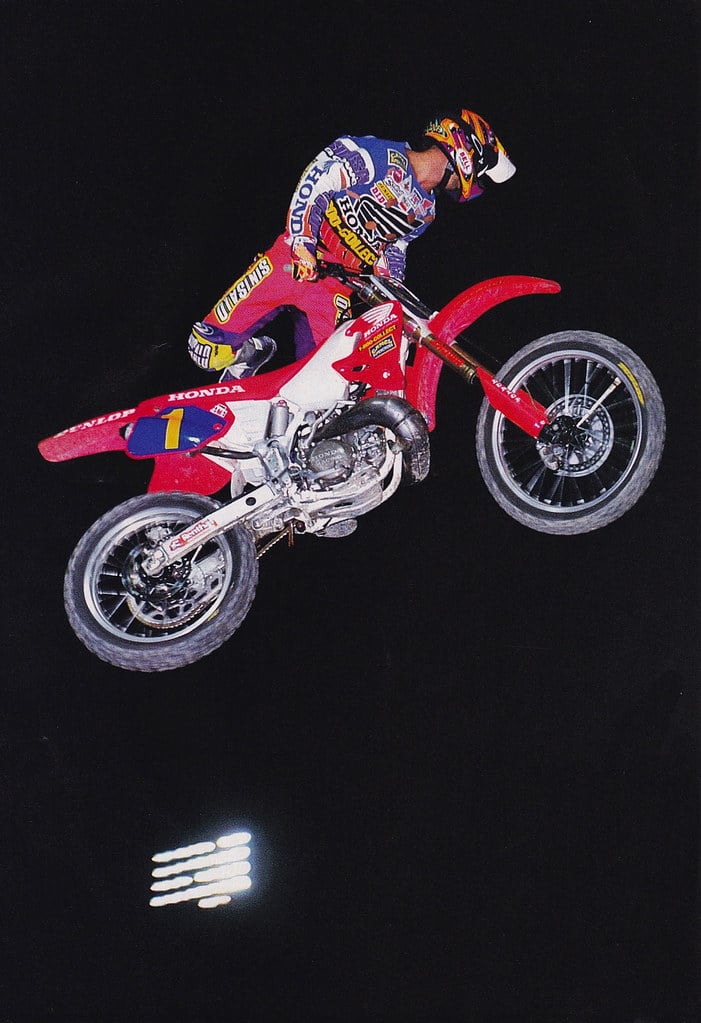
The first nac nac on a motorcycle that the public saw was in November, 1993 in Barcelona during a supercross intermission jump contest. Guy Cooper wowed the crowd with his flat whips and then toward the end of the jam session he saw McGrath come off his motorcycle.
“When you had never seen it before you think there’s going to be a big crash at the end of it,” Cooper said. “Like the first time you saw a back flip.” Cooper remembers the nac nac only getting a mild reaction from the crowd and McGrath didn’t finish in the top three.
The crowd wasn’t sure what he’d done because they were on his left side, which meant that his right leg was coming toward them and it made the maneuver appear less impressive. Cooper, opposite the crowd, was so blown away that he invited McGrath to Cooperland and they spent the week between European supercross races riding, including a session on Cooper’s play bikes, a pair of beat up Suzuki DR350s, which they practiced the nac nac on over a big uphill triple with a forgiving landing. The two took the trick back to Europe and went 1-2 in the next jump contest.

At the beginning of the new supercross season in America, while most riders focused on bringing down their lap times, McGrath used the triples in practice – and on the last lap of the heat race – to send a message to the field: 1993 wasn’t a fluke and I’m so comfortable right now I can make time to do tricks you’ve never heard of. “As a competitor, that’s not what you want to see,” said 1997 Supercross Champion, Jeff Emig. “How are you going to beat this guy? He can do anything on a motorcycle.”
“He wasn’t beating up on the other riders, it was a salute to the crowd and his fans,” Jack McGrath said. Jack had given Jeremy the nickname, “Showtime” and two-time Supercross Champion Ricky Johnson had provided a lot of flashy influence on the young McGrath. But to say Jeremy was actively searching for a signature move, something that was to become his identity, isn’t accurate. He was just having fun.
When freestyle motocross was included in ESPN’s X Games in 1999, McGrath was on the shortlist of invites, according to Paul Taublieb the Moto X sport organizer and the co-director behind “Unchained: The Untold History of Freestyle Motocross” which will make its debut at Sundance 2016. Taublieb wasn’t concerned that McGrath didn’t have lots of tricks. The negotiations never made it past McGrath’s manager, Jeff Surwall and today McGrath chuckles at finding out about being courted. “I’m a one trick pony,” he said. “I would have declined.”
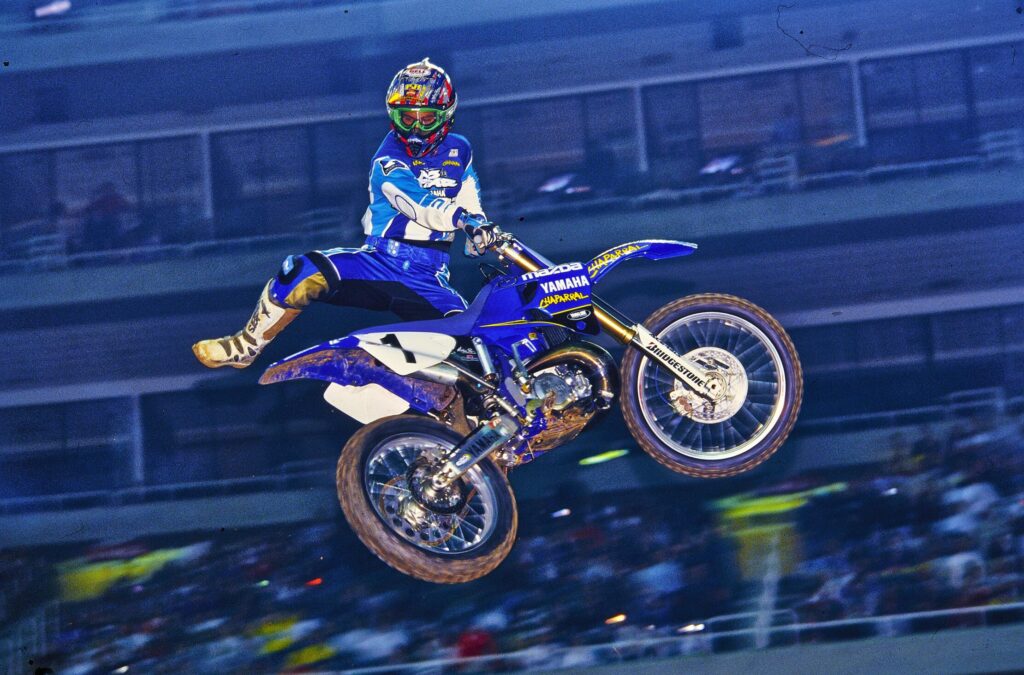
He may have been doing it for the spectators but others perked up as well when Jeremy showed that the motorcycle wasn’t just a functional machine to be used for racing and that it was ok to be an individual and express yourself. Two young men, Jon Freeman and professional snowboarder Dana Nicholson were working on a video at the time.
“Jeremy doing that nac nac definitely got our attention,” Freeman said. “We ate it up and wanted to film with him more.” Later that year their little project – Crusty Demons of Dirt – was released and its cast of characters arguably became more famous than motorcycling itself. Today Freeman is the other director of the “Unchained” documentary.
“The nac nac certainly separated me from the competition in being different,” McGrath said. “That’s just the kind of person I am. I want to be different, different lines, different style, different path.”
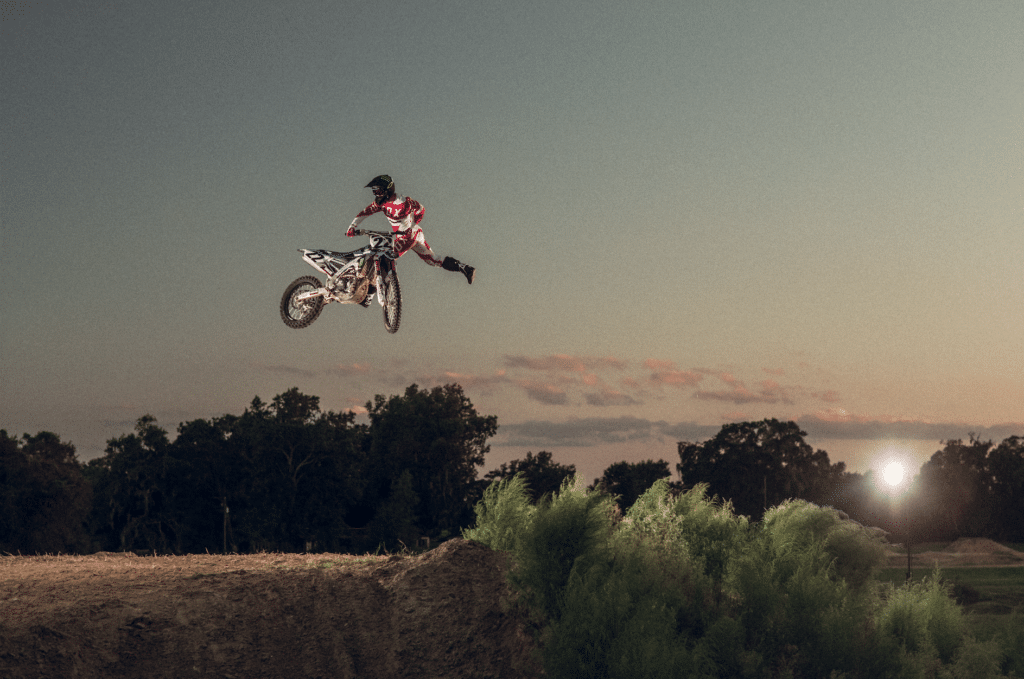
Meanwhile, Down Under…
In Australia, a young man named Chad Reed was winning mini-cycle races on his country’s east coast and started trying the nac nac in his own backyard in 1997, when he was 15. Now a retired two-time Monster Energy Supercross Champion, Reed still enjoys throwing the nac nac at the track, just as casually as Damon Bradshaw once did no-footers or Jeff Ward a finish line fist pump. While McGrath’s style and dominance were appealing to Reed, he also saw something in his attitude and the way he carried himself.
“Even when he might have been struggling, he had this way of making it seem fun and everyone envied that, I think,” Reed said.
It’s interesting that the full history of a BMX trick gets told by a dirt bike brand but that’s because of two reasons:
1. The nac nac was a footnote of a trick in BMX, filler in a contest run and in the 80s, new BMX tricks were being unveiled at every contest.
2. The nac nac had way more impact on motorcycling than it ever did in BMX. The bottom line: if it were not for Jeremy McGrath nobody would be writing anything about the nac nac.
“We had no idea that the little session that went down in that Sun City Backyard would transpire to what it did,” said Eric Carter, who witnessed the very first motorcycle nac nac. “But the same could be said about McGrath, really.”
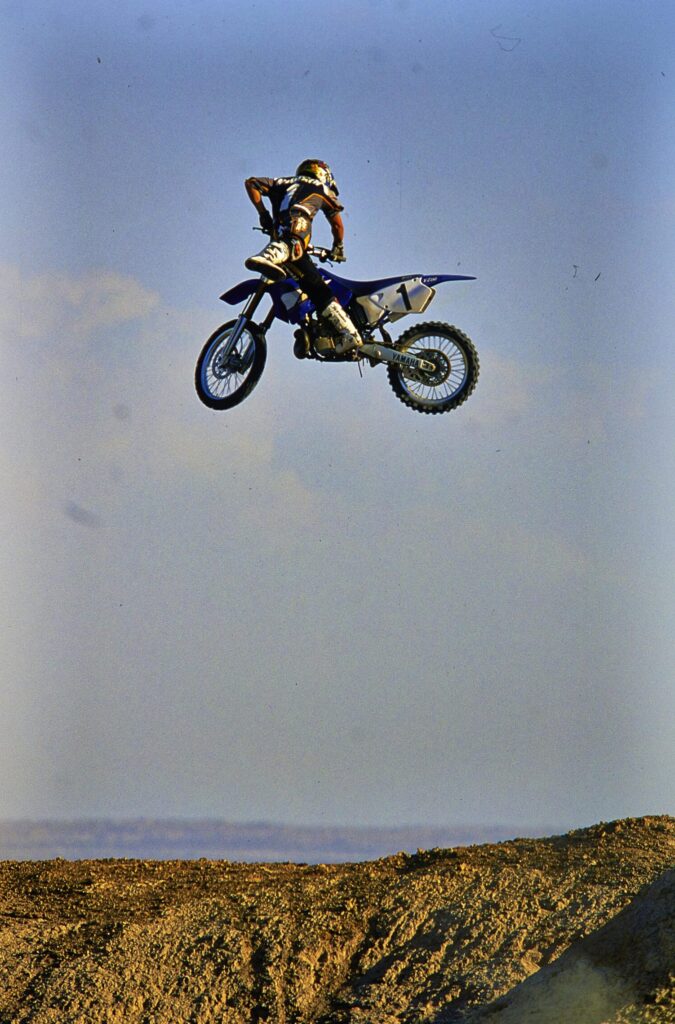
Footnote
McGrath didn’t do a nac nac in the main event that night in Orlando (but a fan snapped a photo from the heat race. See below).
Pressured late in the race by Mike LaRocco, McGrath put his head down and focused on getting to the finish line.
One week later in Houston, he did two nac nacs on the final lap of the heat race. Davey Coombs had his camera ready that day.
